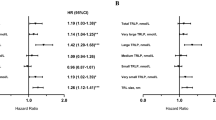Abstract
Background Evidence has been provided that lipoprotein(a) (Lp(a)) may be an important cardiovascular risk factor. Recognition of potential Lp(a) variability associated with common diseases, such as diabetes, chronic renal dysfunction, impaired liver function and acute/chronic inflammation, is important to optimize the clinical usefulness of this measurement. Methods We performed a retrospective analysis on our Laboratory Information System to retrieve results of fasting plasma glucose (FPG), creatinine, albumin, high sensitivity-C reactive protein (Hs-CRP) and Lp(a) tests, which were performed on all outpatients referred by general practitioners for routine blood testing during the last 5 years. Results Cumulative results for all of the above parameters were retrieved for 1,195 adults. After stratifying Lp(a) results according to the respective threshold values of albumin, estimated glomerular filtration rate (e-GFR), FPG and Hs-CRP, a significant difference was observed only among subjects with increased Hs-CRP levels (170 mg/l vs. 125 mg/l; P < 0.001). The frequency of Lp(a) values ≥300 mg/l was greater in those with increased Hs-CRP levels (36 vs. 26%; P = 0.037)—but not in those with abnormal values of albumin, e-GFR or FPG—compared with their counterparts with normal values of these parameters. In multiple regression analysis, age (r = 0.112; P < 0.001), Hs-CRP (r = 0.102; P = 0.001) and e-GFR (r = 0.106; P = 0.003) were independent predictors of Lp(a). Conclusions The evaluation of laboratory markers of glucose homeostasis and liver function seems unnecessary when measuring Lp(a) for cardiovascular risk assessment. Conversely, Hs-CRP and probably GFR might be of clinical value to identify individuals whose serum Lp(a) levels can be transiently or chronically increased.
Similar content being viewed by others
References
Lippi G, Guidi G (2003) Lipoprotein(a): an emerging cardiovascular risk factor. Crit Rev Clin Lab Sci 40:1–42
Pati U, Pati N (2000) Lipoprotein(a), atherosclerosis, and apolipoprotein(a) gene polymorphism. Mol Genet Metab 71:87–92
Kronenberg F, Steinmetz A, Kostner GM, Dieplinger H (1996) Lipoprotein(a) in health and disease. Crit Rev Clin Lab Sci 33:495–543
Kronenberg F, Utermann G, Dieplinger H (1996) Lipoprotein(a) in renal disease. Am J Kidney Dis 27:1–25
Lippi G, Braga V, Adami S, Guidi G (1998) Modification of serum apolipoprotein A-I, apolipoprotein B and lipoprotein(a) levels after bisphosphonates-induced acute phase response. Clin Chim Acta 271:79–87
Lippi G, Caramaschi P, Montagnana M, Salvagno GL, Volpe A, Guidi G (2006) Lipoprotein[a] and the lipid profile in patients with systemic sclerosis. Clin Chim Acta 364:345–348
Alessandri C, Basili S, Maurelli M, Andreozzi P, Violi F, Cordova C (1994) Relationship between lipoprotein(a) levels in serum and some indices of protein synthesis in liver cirrhosis. Clin Chim Acta 224:125–129
National Kidney Foundation (2002) K/DOQI clinical practice guidelines for chronic kidney disease: evaluation, classification, and stratification. Kidney Disease Outcome Quality Initiative. Am J Kidney Dis 39:S1–S246
American Diabetes Association (2006) Diagnosis and classification of diabetes mellitus. Diabetes Care 29(Suppl 1):S43–S48
Lippi G, Guidi G (1999) Biochemical risk factors and patient’s outcome: the case of lipoprotein(a). Clin Chim Acta 280:59–71
DeMeester CA, Bu X, Gray RJ, Lusis AJ, Rotter JI (1995) Genetic variation in lipoprotein (a) levels in families enriched for coronary artery disease is determined almost entirely by the apolipoprotein (a) gene locus. Am J Hum Genet 56:287–293
Saely CH, Koch L, Schmid F, Marte T, Aczel S, Langer P et al (2006) Lipoprotein(a), type 2 diabetes and vascular risk in coronary patients. Eur J Clin Invest 36:91–97
Ramharack R, Barkalow D, Spahr MA (1998) Dominant negative effect of TGF-beta1 and TNF-alpha on basal and IL-6-induced lipoprotein(a) and apolipoprotein(a) mRNA expression in primary monkey hepatocyte cultures. Arterioscler Thromb Vasc Biol 18:984–990
Wade DP, Clarke JG, Lindahl GE, Liu AC, Zysow BR, Meer K et al (1993) 5’ Control regions of the apolipoprotein(a) gene and members of the related plasminogen gene family. Proc Natl Acad Sci USA 90:1369–1373
Lippi G, Franchini M, Guidi GC (2007) Lipoprotein(a), athero-thrombosis and longevity. A historical paradox finally elucidated? Haematologica 92(3 Suppl):ELT03
Espeland MA, Marcovina SM, Miller V, Wood PD, Wasilauskas C, Sherwin R et al (1998) Effect of postmenopausal hormone therapy on lipoprotein(a) concentration. PEPI Investigators. Postmenopausal Estrogen/Progestin Interventions. Circulation 97:979–986
Author information
Authors and Affiliations
Corresponding author
Rights and permissions
About this article
Cite this article
Lippi, G., Targher, G., Franchini, M. et al. Biochemical correlates of lipoprotein(a) in a general adult population. Possible implications for cardiovascular risk assessment. J Thromb Thrombolysis 27, 44–47 (2009). https://doi.org/10.1007/s11239-007-0171-0
Received:
Accepted:
Published:
Issue Date:
DOI: https://doi.org/10.1007/s11239-007-0171-0




